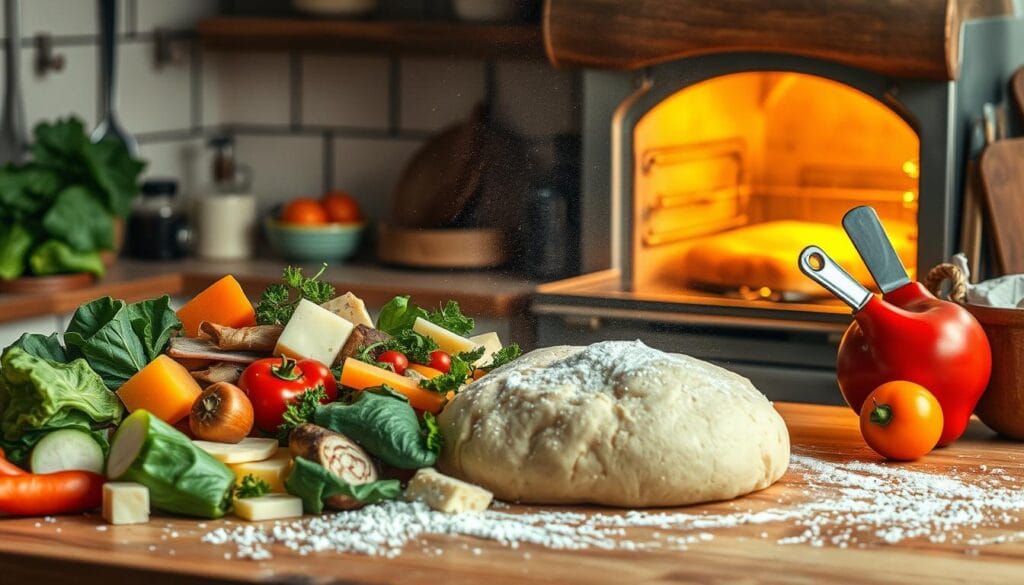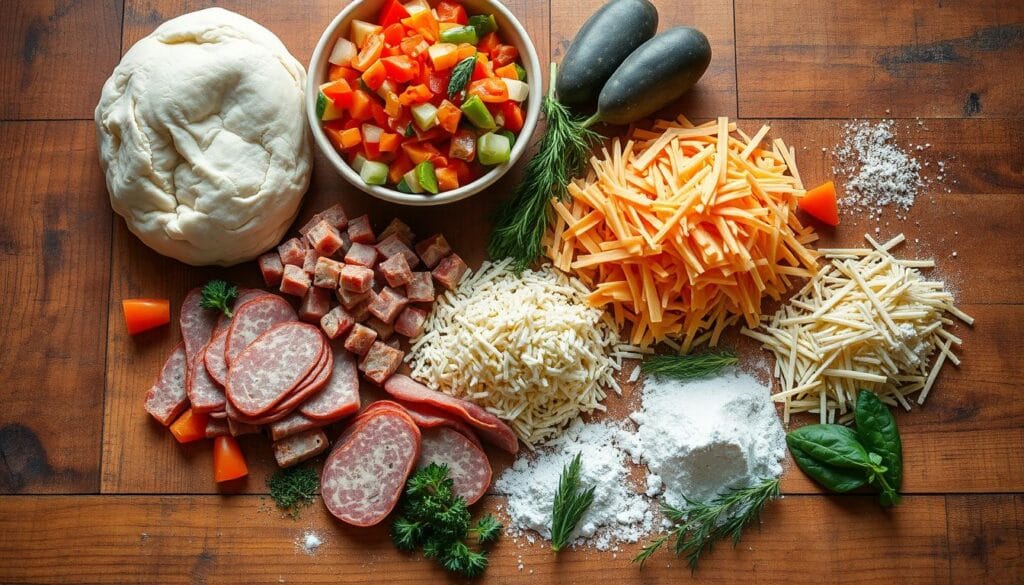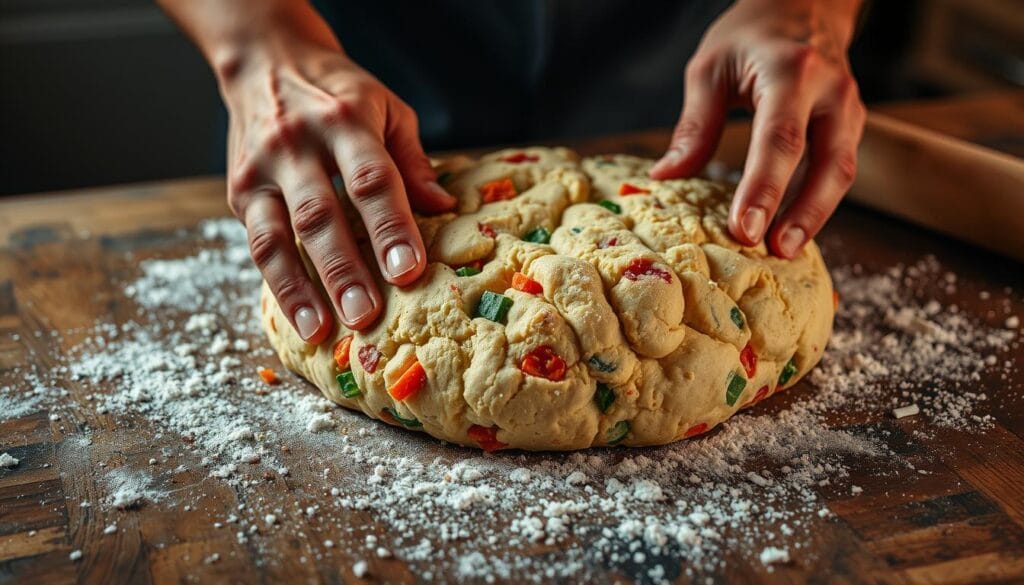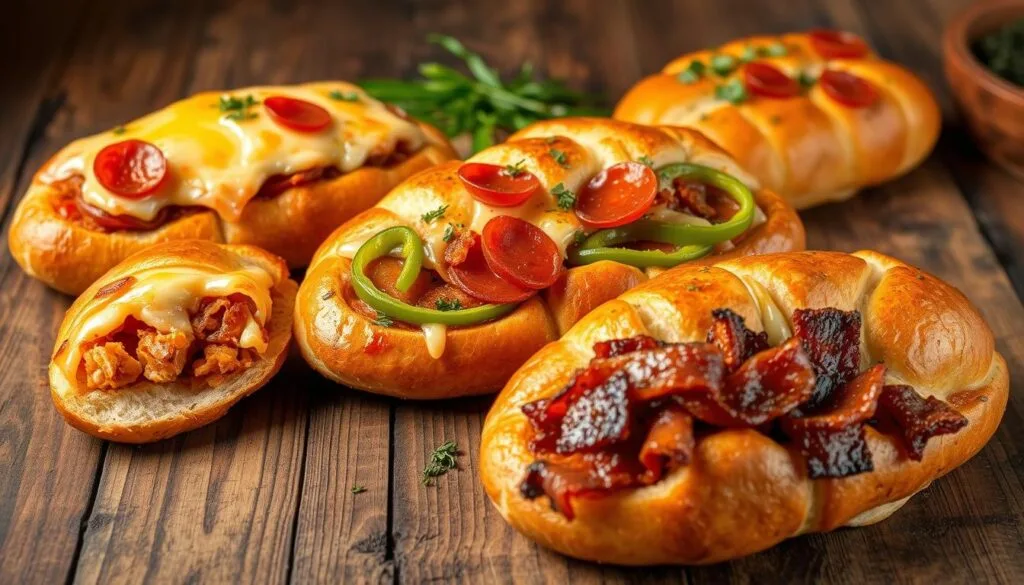Ever looked into your fridge and wondered how to make something amazing from leftovers? Garbage bread is your answer. It’s a creative way to use up food waste and turn it into a tasty treat!
Garbage bread isn’t about throwing away food. It’s about being creative with what you have. You can make an amazing meal from simple ingredients. It’s like a flavor explosion in your mouth, ready to feed six people in 45 minutes.
Want a bacon cheeseburger in a roll or a spicy buffalo chicken version? Garbage bread has it all. It’s easy to make and perfect for saving food from going to waste. You’ll create a dish that’s both delicious and eco-friendly.
Table of Contents
Key Takeaways
- Garbage bread transforms leftovers into delicious meals
- Total preparation time is just 45 minutes
- Each recipe serves 6 people
- Versatile filling options from savory meats to vegetarian choices
- Perfect for reducing food waste creatively
Introduction to Garbage Bread
Garbage Bread might sound weird, but it’s actually tasty. It’s all about using leftovers and cooking sustainably. This dish turns random stuff into a yummy rolled bread that many in the U.S. love.

Origins and Evolution
The idea of Garbage Bread started in homes where people wanted to cut down on food waste. Families mixed leftover meats, veggies, and cheeses into a tasty rolled bread. This way, they reduced kitchen waste.You can explore how to adapt it with seasonal ingredients in the ultimate guide to reducing food waste to make each roll unique.
- Developed from home cooking innovations
- Inspired by reducing food waste
- Blends various leftover ingredients
Why It’s Called Garbage Bread
Garbage Bread isn’t made from trash. Its name is a fun way to say it’s about using what you have. It’s about cooking with what’s in your fridge or pantry.
Popular Cultural Impact
| Cultural Trend | Impact |
|---|---|
| Social Media Shares | 12,125 Facebook shares |
| Serving Size | 4-6 people per recipe |
| Nutritional Popularity | 310 calories per serving |
Garbage Bread has become a big hit online. It shows a new way to cook that’s good for your wallet and the planet. Its simplicity and flexibility have made it a popular trend in cooking today.
Essential Ingredients for the Perfect Roll

Making the ultimate garbage bread begins with picking the right ingredients. This eco-friendly meal turns simple pantry items into a tasty journey. By using upcycled ingredients, you make a dish that’s good for the planet and your taste buds.
Let’s look at the key ingredients for a delicious garbage bread:
- Refrigerated pizza dough (13.8 oz)
- Ground beef or sausage (½ lb, 80/20 fat content)
- Pepperoni slices (½ cup, chopped)
- Shredded cheeses:
- Mozzarella (1 cup)
- Cheddar (½ cup)
- Seasonings:
- Garlic powder (½ tsp)
- Italian seasoning (½ tsp)
- Fine sea salt (½ tsp)
- Black pepper (¼ tsp)
| Ingredient | Weight/Volume | Key Characteristics |
|---|---|---|
| Pizza Dough | 13.8 oz | Stretch to 16×12 inches, 1/8 inch thick |
| Ground Beef | ½ lb | 80/20 fat content, cook to 165°F internal temp |
| Mozzarella | 1 cup | 45-52% moisture, chill to 40°F |
| Cheddar | ½ cup | Aged 6+ months, chill to 40°F |
Garbage bread is all about being flexible. Try different upcycled ingredients you have at home. This way, you reduce waste and make dishes that you’ll love.
Remember, keep your ingredients fresh and stored right. Chilling cheeses and cooking meats to the right temperature ensures your meal is safe and tasty.
The Art of Dough Selection and Preparation
Making the perfect Garbage Bread begins with the right dough. Whether you bake at home or love exploring new recipes, knowing how to prepare dough is key.
Store-bought vs Homemade Dough
Your choice of dough can greatly affect your Garbage Bread. Here are some points to consider:
- Store-bought dough is easy and consistent
- Homemade dough lets you control what goes in
- Pre-made pizza or bread dough is a great choice
Dough Temperature Mastery
Temperature is important when working with dough. Cold dough is hard to handle, but room temperature dough is easier to work with.
| Dough Temperature | Handling Difficulty | Recommended Action |
|---|---|---|
| Refrigerated | High | Let rest at room temperature for 30 minutes |
| Room Temperature | Low | Ready to use immediately |
Rolling Techniques for Success
Rolling the dough right is key for even thickness and to avoid tears. Use a light touch and roll on a lightly floured surface. Start from the center and roll outwards, turning the dough to keep it round.

Remember, the more you practice, the better you get at zero waste baking. Every try helps you waste less food and get better at it.
Classic Filling Combinations
Explore the world of Garbage Bread fillings that turn leftovers into tasty meals. Your kitchen becomes a place where creativity meets sustainability. It’s all about giving leftovers a second chance.
These fillings mix old favorites with new twists. They’re great for using up food and cutting down on waste.
Popular Filling Combinations
- Classic Cheeseburger Style
- Ground beef
- Shredded cheddar cheese
- Diced onions
- Pickles
- Ketchup and mustard
- Italian Inspired
- Pepperoni
- Mozzarella cheese
- Italian seasoning
- Marinara sauce
- Vegetarian Delight
- Roasted vegetables
- Spinach
- Feta cheese
- Sun-dried tomatoes
Each mix offers a special taste while helping the planet.
| Filling Type | Calories | Protein (g) | Fat (g) |
|---|---|---|---|
| Cheeseburger Style | 279 | 5 | 15 |
| Italian Inspired | 265 | 6 | 14 |
| Vegetarian Delight | 245 | 4 | 12 |
Try using local, seasonal ingredients. It boosts flavor and supports the environment in your cooking.
Step-by-Step Assembly Guide
Making the perfect garbage bread needs precision and care. This method turns simple ingredients into a tasty meal, reducing food waste. Let’s explore the steps to make your garbage bread truly special.
Mastering Ingredient Layering
Getting the ingredients right is key for success. Here’s what to do:
- Roll out your pizza dough to 16×12 inches, keeping it 1/8-inch thick
- Leave a 1-inch border around the edges for sealing
- Spread ingredients evenly for balanced flavor in every bite
Rolling and Sealing Techniques
Your rolling technique is vital. Follow these tips:
- Start with cooled, crumbled proteins like ground beef (½ lb, 80/20 fat content)
- Add ½ cup chopped pepperoni and 1 cup mozzarella cheese
- Sprinkle ½ teaspoon Italian seasoning for extra flavor
- Roll tightly from the long side, making a compact log
- Pinch edges firmly to seal and prevent filling escape
Pre-Baking Preparation
The final steps before baking are key for a perfect garbage bread:
| Preparation Step | Details |
|---|---|
| Egg Wash | Brush with 1 large egg at 65°F to create golden crust |
| Seasoning | Sprinkle sesame seeds for extra texture |
| Temperature | Preheat oven to 375°F |
Pay close attention to detail during assembly. This ensures a delicious garbage bread that showcases sustainable cooking. Impress your guests with this versatile, waste-reducing recipe!
Mastering the Baking Process
To make delicious Garbage Bread, you need to be precise in baking. Knowing the right techniques is key. It helps you make a perfect golden-brown treat and cuts down on kitchen waste.
Temperature and timing are very important. Preheat your oven to 375°F (190°C) for even heat. Put your Garbage Bread on the middle rack for consistent cooking.
Baking Checklist for Success
- Set oven to 375°F (190°C)
- Position rack in the middle of the oven
- Bake for 20-25 minutes
- Check bread color and texture
Knowing when your bread is done is an art. Look for these signs:
| Indicator | What to Look For |
|---|---|
| Color | Golden brown crust |
| Sound | Hollow when tapped |
| Texture | Crisp exterior, soft interior |
Pro tip: Use a digital scale for exact ingredient amounts. It cuts down on waste and gives you consistent results. Remember, practice makes perfect!
Mastering these baking techniques lets you make tasty Garbage Bread. It also supports sustainable cooking. Your kitchen becomes a place of creativity and waste reduction.
Creative Variations and Modern Twists
Garbage Bread is more than a recipe; it’s a canvas for creativity. You can turn it into a unique dish by using upcycled ingredients and creative cooking methods. This way, you can make it your own, matching your taste and dietary needs.
Trying out different versions of Garbage Bread lets you see it in new ways. It’s a chance to make this dish exciting and personal. Let’s explore some fresh ideas to take your Garbage Bread to the next level.
Vegetarian Delights
Vegetarian options can be both tasty and fulfilling. Here are some plant-based fillings to try:
- Roasted seasonal vegetables
- Sautéed spinach and mushroom blend
- Caramelized onions with goat cheese
- Grilled zucchini and eggplant with herbs
Global Flavor Inspirations
Explore the world with these international Garbage Bread twists:
| Cuisine | Key Ingredients | Flavor Profile |
|---|---|---|
| Mexican | Black beans, jalapeños, pepper jack cheese | Spicy and bold |
| Mediterranean | Feta, olives, sundried tomatoes | Tangy and herbaceous |
| Asian Fusion | Teriyaki tofu, scallions, sesame seeds | Sweet and umami |
Seasonal Adaptations
Adapting Garbage Bread to the seasons is key to resourceful cooking. Here’s how to do it:
- Spring: Asparagus, fresh peas, light cheeses
- Summer: Grilled corn, tomatoes, fresh herbs
- Autumn: Roasted squash, sage, caramelized onions
- Winter: Root vegetables, hearty greens, rich cheeses
By using upcycled ingredients and being creative, you can turn Garbage Bread into a dish that’s truly yours. It becomes a personal culinary journey.
Serving Suggestions and Pairings
Your Garbage Bread journey doesn’t stop after baking. Choosing the right sides can turn this dish into a memorable meal. It’s all about adding flavor and being kind to the planet.
Recommended Dipping Sauces
- Homemade marinara sauce
- Garlic butter
- Ranch dressing
- Buffalo sauce
- Garlic aioli
Each sauce brings a special taste that goes well with your Garbage Bread. Choose homemade sauces to cut down on waste and help the environment.
Perfect Side Dish Pairings
| Side Dish Category | Recommended Options | Sustainability Factor |
|---|---|---|
| Fresh Salads | Mixed greens, seasonal vegetables | High (local, seasonal produce) |
| Roasted Vegetables | Seasonal root vegetables | Medium (reduced carbon footprint) |
| Light Proteins | Grilled chicken, tofu | Variable (depends on sourcing) |
When you serve Garbage Bread, think about how much to give each person. Aim for 1-2 inch slices. This way, everyone can enjoy it without feeling too full. Your goal is to make a meal that’s good for you and the planet.
Beverage Recommendations
- Local craft beer
- Organic wine
- Sparkling water
- Herbal iced tea
By picking your sides and drinks carefully, you’re doing more than just cooking. You’re making a statement about caring for our planet and eating mindfully.
Storage and Reheating Methods
Learning how to store and reheat your Garbage Bread is key for zero waste baking. It helps keep your food fresh and reduces waste. This way, you can enjoy your bread for days.
Cooling and Initial Storage
Let your Garbage Bread cool down completely before storing. This stops moisture from building up. Wrap each slice carefully to keep it fresh and soft.
- Cool bread at room temperature for 30-45 minutes
- Use airtight containers for best preservation
- Wrap slices individually in plastic wrap or aluminum foil
Refrigeration Techniques
Refrigeration can make your Garbage Bread last longer. It supports zero waste baking. Store it right to keep it tasting great and feeling soft.
- Refrigerate for up to 3 days
- Keep in sealed container to prevent drying
- Place parchment paper between layers to prevent sticking
Freezing Guidelines
Freezing is a great way to save your Garbage Bread. It keeps it fresh for a long time.
- Freeze for up to 2 months
- Wrap tightly in plastic wrap and aluminum foil
- Place in freezer-safe container
- Thaw overnight in refrigerator before reheating
Reheating Best Practices
Here’s how to make your Garbage Bread fresh again:
- Oven method: Preheat to 350°F, wrap in foil, heat for 10-15 minutes
- Toaster oven: 5-7 minutes at 325°F
- Microwave: 15-20 seconds, check every 10 seconds
By using these tips, you’ll enjoy your Garbage Bread more. And you’ll waste less food.
Tips for Recipe Success
Making the perfect Garbage Bread needs some skill. By using leftovers and eco-friendly meals, you can make something amazing from simple ingredients.
Start by choosing your ingredients wisely. Here are some tips to make your Garbage Bread better:
- Use room temperature ingredients for better blending
- Don’t overstuff your roll to prevent splitting
- Experiment with different cheese combinations
- Season generously for maximum flavor
Knowing how much of each ingredient to use is key. Here’s a nutrition guide to help:
| Ingredient | Recommended Amount | Impact |
|---|---|---|
| Cheese | 1-2 cups | Adds richness |
| Protein | 1/2-1 pound | Provides substance |
| Seasonings | 2-3 tablespoons | Enhances flavor |
Being creative with leftovers is key to eco-friendly meals. Trust your culinary instincts and try new things. Garbage Bread is all about being flexible and reducing waste.
Pro tip: Always preheat your oven and use a baking sheet lined with parchment paper. This way, your Garbage Bread will be crispy outside and melted inside.
Conclusion
Garbage bread is more than a tasty dish; it’s a way to cook with care for the planet. It turns leftovers into a delicious meal, helping you waste less food. This makes your kitchen a greener place.
Garbage bread lets you try many flavors. Whether you love veggies or global tastes, it fits your style. It’s quick to make, ready in just 45 minutes, and packed with 18g of protein per serving.
Your journey with garbage bread is about being creative and caring for the earth. Try new ingredients and flavors. Every roll is a chance to make something special and help the planet.
Great cooking is all about being innovative, and garbage bread shows that. It turns simple ingredients into a feast that’s good for you and the planet.
FAQ
What exactly is Garbage Bread?
Garbage Bread is a creative dish made from leftover ingredients. It’s a rolled bread filled with meats, cheeses, veggies, and more. It’s called Garbage Bread because it uses food that might be thrown away, but it doesn’t use actual garbage.
How did Garbage Bread get its unusual name?
The name comes from using random ingredients you have. It’s like cleaning out your fridge or pantry. This way, you use leftovers and it’s good for the environment.
Can I make Garbage Bread if I have dietary restrictions?
Yes! Garbage Bread can be made for many diets. You can make it vegetarian, vegan, gluten-free, or low-carb. Just use what you have and get creative.
What kind of dough works best for Garbage Bread?
You can use pizza dough, bread dough, or make your own. The dough should be the right temperature and thin enough for fillings. This keeps it from being too thick or doughy.
How long can I store Garbage Bread?
Store it in an airtight container in the fridge for 3-4 days. You can freeze it for 2-3 months. Reheat it in an oven or air fryer to keep it crispy.
Is Garbage Bread a budget-friendly meal?
Yes! It’s very affordable. Using leftovers and what you already have makes a tasty meal. It also saves money and reduces waste.
Can kids help make Garbage Bread?
Yes! Kids can help pick ingredients, mix fillings, and roll the bread. It’s a fun way to teach them about cooking and being creative.
Are there any tips for preventing the filling from leaking?
To stop leaks, don’t overfill the bread. Seal the edges well. Use little liquid and brush with egg wash. Make small slashes on top for steam.
Can Garbage Bread be made ahead of time?
Yes! You can make it ahead and refrigerate it. Or bake it, then reheat it later. It’s great for meal prep or parties.
What are some classic filling combinations?
Popular fillings include: – Pizza-style with pepperoni, cheese, and marinara – Philly cheesesteak with beef, peppers, and onions – Buffalo chicken with ranch dressing – Vegetarian with roasted veggies and cheese – Breakfast-style with scrambled eggs and bacon

